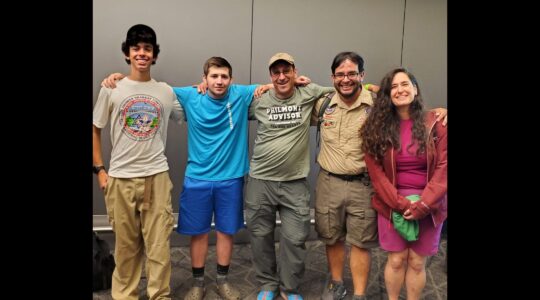
Nearly 900 people attended the recent International Association of Jewish Genealogy Societies conference in Philadelphia. (Eugene Hurwitz)
PHILADELPHIA (JTA) — In genealogy research, crumbling documents and high-speed Internet connections often go hand in hand.
So it goes for Schelly Talalay Dardashti.
At a workshop she ran a few years ago in Barcelona on the role of technology in conducting genealogy research, Dardashti met a former attorney, Maria Jose Surribas. Surribas now works as a freelance genealogist and has helped Dardashti research her roots in the Catalonian town of Lerida.
Dardashti now can trace her family there to 1353, to Moshe Talalaya, a kosher winemaker.
“If not for technology, we’d be doing what we used to: dealing with the dust and the creepy-crawlies, like Maria does in Spain, wearing a face mask,” said Dardashti, of Tel Aviv, who writes the Tracing the Tribe: The Jewish Genealogy Blog. “Technology has made it possible for people interested in the same topics to share, collaborate and learn.”
The ever-expanding research opportunities enabled by technology was a central theme at the recent conference in Philadelphia of the International Association of Jewish Genealogy Societies, which drew nearly 900 people.
Last year’s conference session on using Google for genealogy research proved so popular that three Google sessions were held this time.
Speakers, including representatives of companies specializing in technology-assisted genealogy, covered such matters as constructing digital family trees and sharing them online, searching databases, choosing genealogy software, collaborating with other researchers via social networking sites and utilizing face-recognition technology to identify relatives in photographs.
“Until now history and genealogy, which are related, are things that old people were said to be doing,” said Daniel Horowitz, manager of genealogy and translations for MyHeritage, an Israeli software and Web company that operates in 36 languages.
That reality is changing, he said, as modern tools make learning about the past cooler.
“Definitely, technology plays a very important role in bringing young people into genealogy,” Horowitz said. “Once the computer and technology are used to research or share information, young people are attracted to it. The amount of young people getting involved in things like Facebook — it’s incredible. In Israel, there’s a Facebook for kids 12-15 years old. That’s a very good catch to bring young people into genealogy.”
While few teenagers and 20-somethings attended the conference, some spoke of their young children catching the genealogy bug.
Barbara and Richard Wissokur came from Boston with their daughter, Amy Wissokur Graham, a Philadelphia librarian. When Barbara periodically updates the family database, she e-mails Amy, who shares the information with her three children for their class assignments.
“They’ve been working on this so long,” Amy said of her parents, “that my mother is counting on me to move this forward.”
Technology has proven itself to Ruth Epstein-Glicksberg and her husband, Moshe, retirees in Haifa. Ruth has compiled much of her family’s history by hand on assorted scraps of paper. She started transferring the data onto a computer program, Family Tree Maker, but said she is thinking of switching to MyHeritage’s Family Tree Builder after hearing a session about it at the conference.
“It’s terrible because it’s a mess,” she said of her scattered notes. “It’s lots of work, it’s inefficient and it’s not organized. This computer program is good for me because it gives me many possibilities to organize my material and search other databases. Technology triggers the possibilities for genealogy.”
The couple already has visited Salt Lake City twice to search the vast Mormon collection of microfilmed European records. Ruth perused thousands of documents and discovered death records for her grandparents and other relatives.
Moshe does Internet research of people whose names are written on the back of old family photographs. To learn more about the branch of his family that left Belarus and Lithuania for the United States, he often conducts online searches of U.S. census records and the Social Security Death Index.
New opportunities continue to open up.
The International Tracing Service archives in Bad Aronson, Germany, is a font of newly declassified information. MyHeritage now links researchers to 1,536 databases around the world.
Ancestry.com says it spends millions of dollars per year digitizing records that can be searched online. Even before records are indexed, said the company’s indexing manager, Crista Cowan, Ancestry.com users can browse such digitized documents as naturalization papers much like scrolling microfilm spools.
Many software programs also enable the posting of family trees online, which allows relatives to share and edit each other’s information. For privacy reasons, users can restrict access to the trees; some sites limit what information can be viewed.
“What all this means is, if you have an Internet connection and are sitting in a yurt in Mongolia, you can find out information,” Dardashti said. “What we always say is, if you don’t find what you’re looking for today, try tomorrow.”
JTA has documented Jewish history in real-time for over a century. Keep our journalism strong by joining us in supporting independent, award-winning reporting.





